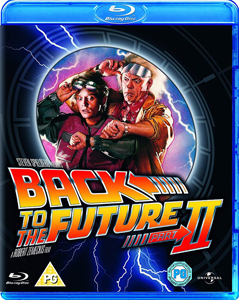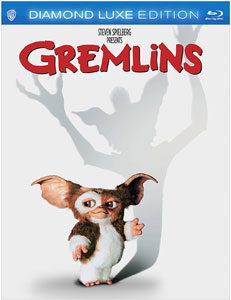“Back to the Future Part II” (1989) is a master class in plotting, as Bob Gale tells the latest adventure of time-traveler Marty McFly (Michael J. Fox) within the nooks and crannies of his first 1955 journey in “Back to the Future” (1985).
Meanwhile, director Robert Zemeckis and his team masterfully intersperse new footage with familiar shots from the first film; this must’ve been tons of fun for moviegoers at the time, and honestly, it still is.
Unrelenting urgency
I like “Part II” slightly less than the original, though. “BTTF” is a delightful comedy with the sci-fi elements letting us know the urgency of the situation. The sequel is a notably urgent film. Granted, it has funny one-liners, like when Doc Brown (Christopher Lloyd) decides the next mystery he’ll tackle is “women.” But it’s rarely breezy fun.

“Back to the Future Part II” (1989)
Director: Robert Zemeckis
Writers: Bob Gale (screenplay, story), Robert Zemeckis (story)
Stars: Michael J. Fox, Christopher Lloyd, Lea Thompson
“Part II” is dominated by Biff (Thomas F. Wilson), who harasses Marty across time – well, OK, the 2015 version is Griff, Biff’s grandson. Even watching this movie as a kid, I noticed how Biff/Griff is a shadow hanging over everything. Biff genuinely wants to kill Marty. This is rather grim stuff for a family film.
The opening trip to 2015 is a blast, though, as it puts Gale and the film’s futurist consultants to work. They grade out pretty well, but for every pair of brilliant predictions, there’s an absolute groaner. Still, I admire the bravery of the attempt, knowing that when 2015 arrived in a mere 26 years, people would potentially be laughing at them.
Predicting the future
Among the spot-on predictions are flat-screen TVs with voice command, sequelitis at movie theaters (“Jaws 19” is the tentpole picture), 1980s nostalgia (via the diner), a thumb-print payment system, dogs being walked with drone collars, and Big Data (note the detailed information on each person that accompanies Marty’s video-screen phone calls).
Among the groaners are ubiquitous fax machines, and cellphones that are connected to the house rather than tied to the person. It’s amazing how many SF storytellers missed the boat on cellphones considering that cellphone tech was in development for many years before it was implemented; indeed, bulky early cellphones were in use by 1989.
The same goes for digital communication; extrapolating fax machines out to 2015 (with the idea that they’d be cheap and plentiful), rather than foreseeing email communication (which was in its early days in 1989), is a big swing and miss.
As for flying cars, hoverboards, self-lacing sneakers and self-fitting and self-drying jackets, those are all things that should’ve been here by 2015. So that’s a case of the futurists lecturing society of the future and having good points.
And I love the continuity that finds Marty on a makeshift skateboard in 1955, a skateboard in 1985 and a hoverboard in 2015. The “BTTF” saga is smart in showing how people smoothly adjust to technology rather than marveling at it.
Smart time-travel rules
And again, the time-travel rules are smart, and nicely communicated as Doc maps it out to Marty (and us) on the blackboard of his ruined lab in 1985A (alternate 1985). They can’t go back to the future to fix the timeline, because they’re on an alternate timeline now. They have to go to the past, before it branched off when teenage Biff received the Sports Almanac from old Biff.
While 2015 is colorful and fun – with Fox brilliantly playing a head-spinning number of roles in the McFly family scene – the darkest year of the movie is 1985A. Marty’s childhood neighborhood is a (rather tackily decorated) slum and his home is occupied by a different family. (I won’t dwell on the fact that it happens to be a black family, although I imagine there have been analyses written about this narrative choice.)
The 1985A portion excises comedy and allows Lea Thompson to again show her range, still as Marty’s mom but in this timeline as Biff’s wife as well. Lorraine gave in to the rapey Biff and his riches over the years. This makes her seem rather pathetic, which is as much of a downer as the revelation that Marty’s dad is dead.
Although “Part II’s” plot gets resolved – much preferable to a cliffhanger ending — we don’t get the satisfaction of our heroic duo returning home to 1985 and seeing everything back to normal.
The clever changing newspaper headlines assure us everything is fine, but still, it’d be nice to see Jennifer and Doc’s dog Einstein again. And normalized newspaper headlines aside, it bothers me that Marty leaves his 2015 hoverboard lying on the side of the road in 1955.
A cynical teaser
Instead, we’re thrown into a cynical teaser for the Old West-themed “Part III” that doesn’t include Jennifer or Einstein, and it’s one last example of the darker tone of this entry.
The tag is historically fascinating, though, as it’s one of the earliest examples of something that’s now ubiquitous. Some modern superhero films include as many as three tag scenes amid the closing credits.
This one is just a collection of clips from “Part III,” which was filmed concurrently with “Part II” and which we’re told is coming in Summer 1990. The promotion team’s goal was to be absolutely sure that all viewers of this movie knew the next one was coming.
After all, the internet wasn’t around yet, and even “Part II’s” futurists failed to even dream of such a thing.


